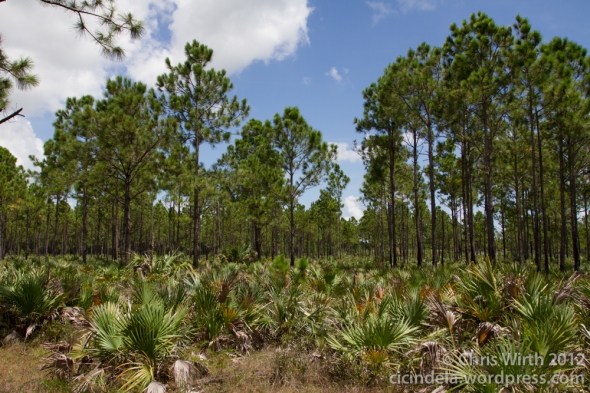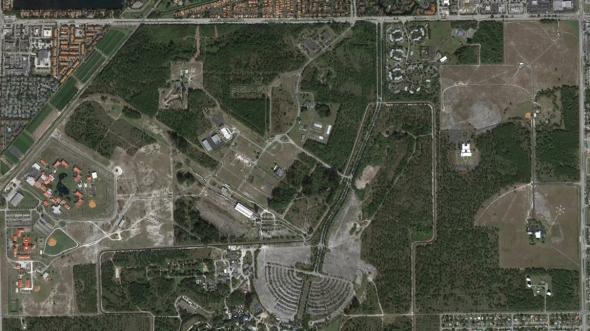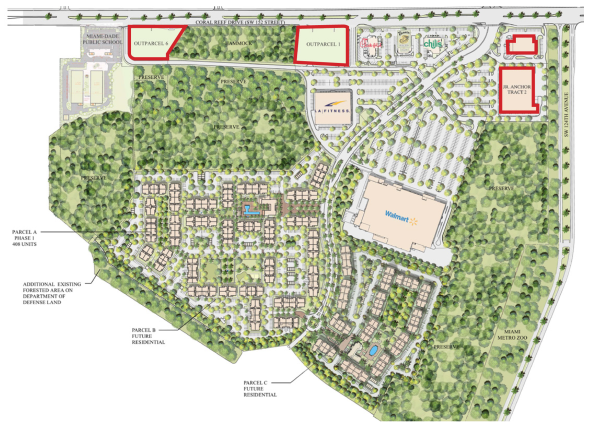The Miami tiger beetle receives “Endangered” status

The Miami tiger beetle, Cicindelidia floridana, and its story are unique. An 18-year-old student first collected the species in 1934 from pine rockland habitat in northern Miami-Dade. Pine rocklands were once the dominant habitat in south Florida, extending from the Florida Keys to the northern border of Miami-Dade County, but development has steadily engulfed this habitat. Today 1.8% of the metro Miami-Dade pine rocklands remain standing.

In the context of this widespread habitat loss and seventy years without any beetles observed the Miami tiger beetle was presumed extinct. But, in 2007 a population of Miami tiger beetles was rediscovered in the Richmond Heights pine rocklands, the largest contiguous remaining rocklands in Miami-Dade (below), and in 2015 a second population was found at an undisclosed patch of pine rocklands nearby.

The Miami tiger beetle faces the immediate threats of habitat loss, degradation, and fragmentation from inadequate habitat management and two proposed developments; a mixed-use development, Coral Reef Commons (below) and a major theme park, Miami Wilds.

Distressingly, the species is also actively sought by private, non-scientist tiger beetle collectors due to its extreme rarity.
On December 11th 2014, the Center for Biological Diversity, Miami Blue Chapter of the North American Butterfly Association, South Florida Wildlands Association, Tropical Audubon Society, Sandy Koi, Al Sunshine, and I submitted a petition to U.S. Fish and Wildlife Service, urging the Miami tiger beetle be formally listed under the Endangered Species Act.
Today, on October 4th 2016, the Service announced the Miami Tiger Beetle will receive “endangered” status under the Endangered Species Act which will become effective on November 4th 2016.
The Miami tiger beetle joins other Federally listed (threatened and endangered) pine rockland endemics, including the Florida Bonneted bat (Eumops floridanus), Florida leafwing (Anaea troglodyta floridalis), Bartram’s hairstreak (Strymon acis bartrami), Blodgett’s silverbush (Argythamnia blodgettii), Florida brickell-bush (Brickellia mosieri), Big Pine partridge pea (Chamaecrista lineata var. keyensis), deltoid spurge (Chamaesyce deltoidea deltoidea), wedge spurge (Chamaesyce deltoidea serpyllum), Carter’s small-flowered flax (Linum carteri carteri), sand flax (Linum arenicola), and tiny polygala (Polygala smallii).
This species also joins other listed members of the Cicindelinae; there are two endangered tiger beetle species (Cicindela ohlone and Ellipsoptera nevadica lincolniana) and two threatened species (Ellipsoptera puritana and Habroscelimorpha dorsalis dorsalis).
However, no critical habitat has been proposed or designated at this time:
While the designation of critical habitat is prudent, the Service is delaying a proposed designation at this time and expects to complete work on it by September 30, 2017. In addition, there is a proposal to build two developments in the Richmond Pine Rocklands and the Service continues to work with developers.
It would appear that the interests of a few private individuals at Ram Realty and Miami Wilds LLC are taking precedence to the survival of the Miami tiger beetle, its fellow pine rockland endemic species, and the last 1.8% of the metro Miami-Dade pine rocklands. The publicly available plans released by the Coral Reef Commons and Miami Wilds developers show that un-surveyed pine rocklands and Miami-tiger-beetle occupied habitat, respectively, will be paved over and the stifling development will severely limit any management of the remaining habitat, chiefly by preventing controlled burns which pine rocklands and their inhabitants depend upon.
Despite this shortcomings, I sincerely thank the staff members of the South Florida Ecological Service. I’d also like recognize the efforts of my fellow Petitioners and extend my thanks.
Please stay tuned to this blog for updates on the Miami tiger beetle and its habitat.

References
Bousquet, Y. 2012. Catalogue of Geadephaga (Coleoptera, Adephaga) of America, north of Mexico. ZooKeys 245:1-1722.
Brzoska, D., C.B. Knisley, and J. Slotten. 2011. Rediscovery of Cicindela scabrosa floridana Cartwright (Coleoptera: Cicindelidae) and its elevation to species level. Insecta Mundi 0162:1-7.
Cartwright, O.L. 1939. Eleven new American Coleoptera (Scarabidae, Cicindelidae). Annals of the Entomological Society of America 32:353-364.
Center for Biological Diversity. 2016. Four Florida Plants Protected Under Endangered Species Act. Press Release. September 28, 2016
Florida Natural Areas Inventory (FNAI). 2010. Pine Rockland, in Guide to the natural communities of Florida: 2010 edition. Florida Natural Areas Inventory, Tallahassee, FL. 8 pp.
Knisley, C.B. 2008. Current status of the “Miami” tiger beetle. Final Report. October 28, 2008.
Knisley, C.B. 2011. Taxonomy, biology, and conservation of the Florida tiger beetle. Final Report to South Florida Ecological Services Office. February 20, 2011.
Knisley, C.B. 2013. Biological studies of the Florida tiger beetle, 2011-2013. Final Report. April 13, 2013.
Knisley, C.B. 2015. Species assessment of the Miami tiger beetle, Cicindelidia floridana. Revised Report. June 6, 2015.
Knisley, C., M. Kippenhan, and D. Brzoska. 2014. Conservation status of United States tiger beetles. Terrestrial Arthropod Reviews. 7: 93-145.
Natureserve 2016. NatureServe Explorer: An online encyclopedia of life. Version 7.0.
Pearson, D.L., C.B. Knisley, and C.J. Kazilek. 2006. A field guide to the tiger beetles of the United States and Canada: Identification, natural history and distribution of the Cicindelinae. Oxford University Press, New York.
Pearson, D.L., C.B. Knisley, D.P. Duran, and C.J. Kazilek. 2015. A field guide to the tiger beetles of the United States and Canada: Identification, natural history and distribution of the Cicindelinae. Second edition. Oxford University Press, New York.
U.S. Fish and Wildlife Service. South Florida Multi-Species Recovery Plan: Appendix C. Species of Concern and their Associated Community Types in South Florida.
URS Corporation, The Institute for Regional Conservation, and Muller and Associates, Inc. 2007. Miami Dade County Environmentally Endangered Lands Program Management Plan, Part II: Management of specific habitat types, Chapter 1: The pine rockland habitat. Submitted to Environmentally Endangered Lands Program, Miami, Florida by URS Corporation. K.A. Bradley, G.D. Gann, M.J. Barry, contributors.
USFWS Miami Tiger Beetle Hearing: Comments
Introduction:
On December 11th 2014, the Center for Biological Diversity, Miami Blue Chapter of the North American Butterfly Association, South Florida Wildlands Association, Tropical Audubon Society, Sandy Koi, Al Sunshine, and I (the Petitioners) submitted a petition to U.S. Fish and Wildlife Service (the Service), urging the Miami tiger beetle (MTB), Cicindelidia floridana, be formally listed under the Endangered Species Act.
A full year and seven days later, on December 18th 2015, the Service proposed “endangered” status for the MTB, and announced a “hearing for members of the general public to comment on that proposal in person,” as required by Section 4(b)(5) of the Endangered Species Act.
This public hearing was held on January 13, 2016 at Miami-Dade College’s Kendall campus and I flew in from Arizona to attend. I’ve already posted a brief synopsis, audio, and photos from the hearing and in this post I’m going to respond to “three” commenters.
Ram Realty’s Habitat Conservation Plan
Author’s Note: Please excuse this belated and partially off-topic post; I’ve written these comments because I feel it is important to highlight the conduct of Ram Realty and to present the best available facts concerning the potential development of Coral Reef Commons site.
In May 2015 Ram Realty filed a lengthy Habitat Conservation Plan (HCP) with the US Fish & Wildlife Service (USFWS) for the development of Coral Reef Commons (CRC). In a press release Ram claimed the HCP, prepared by Johnson Engineering Inc., is a “science-based document” despite the fact that this document contains grievous misrepresentations of the facts. Below I’ve responded to Ram’s most egregious claims, chiefly the present state of the site and the impacts of the development.
No Take of Listed Species?
In their project overview Ram expresses their intent to secure a 50-year Incidental Take Permit (ITP) while, at the same time, insisting that the CRC development:
[W]ould not result in a take [death] of listed species, nor … adversely impact listed species. (Ram 1-2)
This “no take” scenario is absolutely impossible; almost half (48%) of the site is globally imperiled pine rocklands and a majority of the property is USFWS designated critical habitat for four endangered species. Despite their protestations to the contrary Ram’s HCP explicitly calls for the destruction of endangered plants and the host plant for two endangered butterflies.





